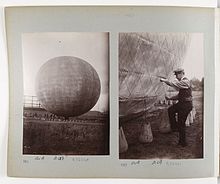ballast
As ballast (NDT. Bare load ) is material of high weight, but low-value referred to. In shipping , ballast is used for stabilization, in aviation to regulate lift or glide angle and in cranes to lower the center of gravity. In addition to water ballast , sand is also used, sometimes metals or stones.
shipping
In the seafaring used mainly water ballast, which is carried in special tanks. He is taken on board to contribute to the necessary stability of the ship and to achieve the most favorable draft and the desired trim . A merchant ship without cargo therefore travels in ballast or in ballast in maritime parlance .
Up until the 19th century, ballast was also used to describe heavy, but almost worthless cargo such as stones or sand.
In yachting and sailing , water ballast is used to increase the righting moment of the boat / ship. Water is pumped to windward in tanks so that the vehicle can sail more upright. This saves weight in the keel . However, this technology requires some space (tanks and pump technology) and is therefore almost exclusively used in regatta ships. Most of the ballast is poured into the keel. Because of its very high density, lead is particularly suitable for this. Scrap iron or concrete is also used because they are cheaper.
In sailing boats , water ballast can be used - even if there is no sailing sport trim ambition - to make a boat easier to transport; The ballast is only filled in when the boat is launched.
aviation

Vehicles lighter than air ( balloons , airships ) use ballast to compensate for loss of lift. Mostly water or sand ballast is carried along, which can be thrown off if necessary to make the aircraft lighter.
Some large airships used to use ballast water extraction systems to compensate for the increase in lift caused by fuel consumption . Some rigid airships were able to cool the exhaust gases from the engines using outside air and use the condensing water to compensate for the fuel consumed.
High-performance gliders use (water) ballast in order to increase their base speed under appropriate thermal conditions, since the maximum glide ratio , and thus the range in gliding flight , is independent of the weight of the aircraft.
In the test phase of new vehicles (aircraft, rail vehicles), their behavior is tested with different total weights and weight distributions with the help of ballast.
Water ballast
is used for:
- Funicular railways as a drive - water ballast railway
- Cargo ships
- Glider
- Sailing ships
also
- Submarines and
- Ships and airships of all kinds use water as ballast to control the situation
Web links
Individual evidence
- ^ F. Sturm, G. Molt: Ballast water production in the airship LZ 130 "Graf Zeppelin" . In: VDI-Zeitschrift , Volume 83, No. 15, April 15, 1939 (as reprint in Peter Kleinheins, Wolfgang Meighörner (Ed.): The great Zeppelins - The history of airship construction . 3rd revised edition. Springer, Berlin 2005 , ISBN 3-540-21170-5 . )
- ↑ In number 4 only bottles fly . In: Stern , May 18, 2006
